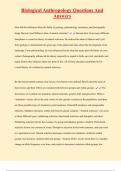Exam (elaborations)
Biological Anthropology Questions And Answers
- Course
- Institution
Biological Anthropology Questions And Answers How did the influences from the fields of geology, paleontology, taxonomy, and demography shape Darwin's and Wallace's idea of natural selection? Darwin drew from many different disciplines to create his theory of natural selection. He utilized t...
[Show more]



